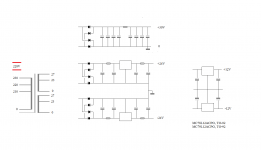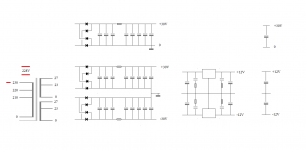Zout is inversely related to load current, when you make this adjustment.......
would the LED/resistor 'bleeder' do this trick
funny
but thought I could hear the sound changing a bit when I experimented with the resistor value, to try and control how bright I liked the LED to glow
Yes, a bleeder resistor will effectively reduce Zout. I have a niece who breaks out in hives at the thought of consuming more electrons than absolutely necessary, however.
The only MC series I have here are MC7915CT, I thought I had some of the MC7815 but they all seem to have been used. I'll include a couple of devices on my next Mouser order and put them on the PSRR/Zout machine for comparison.
The only MC series I have here are MC7915CT, I thought I had some of the MC7815 but they all seem to have been used. I'll include a couple of devices on my next Mouser order and put them on the PSRR/Zout machine for comparison.
Kean -- to your point about the pass transistor -- the ft of the D44H11 is 50MHz, and the MJE200 is 65MHz -- you can see the effect of the gain here -- which reduces Zout. This is simmed from the original article with the AD797AN:
An externally hosted image should be here but it was not working when we last tested it.
The MJE200G is even better than the MJE150xx. Too bad I didn't know this transistor existed. More gain droop at those frequencies probably means lower stability margin. Output impedance should be measured directly and compensation adjusted to eliminate resonances (typically in the 10MHz region).
In my experience linear regs might show small-signal Zout low into the hundreds of KHz in simulation but they readily saturate the output devices when dealing with real signals of these frequencies, which creates just more EMI and distortion, and interrupts regulation. So I hesitate to use any regulator that doesn't accept decoupling. This was part of the reason I developed the Kmultipliers. Regulators can be designed to allow decoupling AND still have incredible performance. My Kmultipliers aren't incredible but they are blazing fast, as well as benign to decoupling, which allows them to filter RF noise very effectively.
Another issue is that source impedance can modify output impedance. A normally benign linear reg can become unstable into capacitive loads depending on the input decoupling.
In my experience linear regs might show small-signal Zout low into the hundreds of KHz in simulation but they readily saturate the output devices when dealing with real signals of these frequencies, which creates just more EMI and distortion, and interrupts regulation. So I hesitate to use any regulator that doesn't accept decoupling. This was part of the reason I developed the Kmultipliers. Regulators can be designed to allow decoupling AND still have incredible performance. My Kmultipliers aren't incredible but they are blazing fast, as well as benign to decoupling, which allows them to filter RF noise very effectively.
Another issue is that source impedance can modify output impedance. A normally benign linear reg can become unstable into capacitive loads depending on the input decoupling.
Now that is an excellent point often unremarked upon.Another issue is that source impedance can modify output impedance. A normally benign linear reg can become unstable into capacitive loads depending on the input decoupling.
Staying with the humble LM317 Errol Dietz' NatSemi paper notes that output peaking problems from a poor choice of output cap is reflected into the input of the reg about 20dB down. And experimentation with input decoupling on a wide range of reg experiments has fairly well convinced me that the input condition really is quite important when chasing the performance you hope for - something with a hint of critical (resistive) damping is a very much more forgiving characteristic. In other words, a low raw feed Z, with immediate input decoupling constituting series RC is potentially far more effective than merely 'a big cap' or 'a small HF cap' or other folkore fixes. This appears to me especially true when using a bootstrap / tracking pre-reg approach - the intermediate node between regs demands more consideration than it is often given. (here's something I wrote earlier, without any maths applied: http://www.acoustica.org.uk/t/3pin_reg_notes4.html)
And where this input decoupling returns to also matters. Ultimately it is decoupling the load, so it wants to return to the output load 0v return point - not the raw supply 0v input (if you need to knock-off incoming supply HF noise, do that separately before the reg)
Last edited:
..... or other folkore fixes.
the way you say it, I reckon anything else than using a professional scope goes into that category
Some simulations with some older devices -- personally i like the MJ15003 and in an amplifier -- but as a pass device:
An externally hosted image should be here but it was not working when we last tested it.
Tinitus, the input RC may work if there is a decoupling right in front of the R to chip ground. You can experiment by adding something like a 1R9+1u snubber at the input to ground right next to the reg. If you can use non-inductive resistors, try values for the R between .22R and 2.2R. Alternatively something like an amplifier L/R zobel could be placed at the input and this may allow for a smaller snubber.
I don't see much of a benefit from giving individual circuit their own regulators if they are analog class A circuits. I would put switching circuits like class AB drivers together on their own rail, and make a separate rail for linear stuff.
However the more current you can draw from the chip the better, as this will decrease Zout, so I would use as few chips as I could.
One way to think about it is, say a reg has 100mR Zout at 10mA and 50mR Zout at 20mA. You have two circuits which each draw 10mA. With both circuits on the same rail, you get double the reg loading, but half the reg Zout, so the rails experience the same voltage fluctuation regardless of whether you use individual regs or not.
Of course I don't know whether the chip reg follows the Zout rule this closely. It could be that it behaves this way only under 100mA and then flattens out above that point, in which case it could be better to use individual regs if the circuit draws over 100mA.
However the more current you can draw from the chip the better, as this will decrease Zout, so I would use as few chips as I could.
One way to think about it is, say a reg has 100mR Zout at 10mA and 50mR Zout at 20mA. You have two circuits which each draw 10mA. With both circuits on the same rail, you get double the reg loading, but half the reg Zout, so the rails experience the same voltage fluctuation regardless of whether you use individual regs or not.
Of course I don't know whether the chip reg follows the Zout rule this closely. It could be that it behaves this way only under 100mA and then flattens out above that point, in which case it could be better to use individual regs if the circuit draws over 100mA.
..... snubber at the input to ground right next to the reg....
..... the more current you can draw from the chip the better, as this will decrease Zout, so I would use as few chips as I could.
you only mention snubber at input
none at output ?
and yes, must not forget, real important to keep the current draw on its toes
clear text, thanks!
Why?...................................If you're going to use the LM317/337 avoid the temptation of using more than a few tens of uF on the adjust pin --
What is the problem that we need to avoid/measure/see on the scope or DMM?
on Rifa site there is paper on Kem High Voltage Polymer Tantalium Caps
says a 15uf/35V will have 100mOhm
might be possible to find a few small size lytics with this relatively low impedance
but many small lytics could have much higher ESR
small lytics does have much lower 'lifetime' specs, due to its small size
but for normal hifi conditions it may not matter much at all
have been studying endless caps specsheets for a few weeks now and know almost every small caps now
and know almost every small caps now
just let me know what specs you need
says a 15uf/35V will have 100mOhm
might be possible to find a few small size lytics with this relatively low impedance
but many small lytics could have much higher ESR
small lytics does have much lower 'lifetime' specs, due to its small size
but for normal hifi conditions it may not matter much at all
have been studying endless caps specsheets for a few weeks now

just let me know what specs you need
- Status
- This old topic is closed. If you want to reopen this topic, contact a moderator using the "Report Post" button.
- Home
- Amplifiers
- Power Supplies
- Best low noise regulator?


